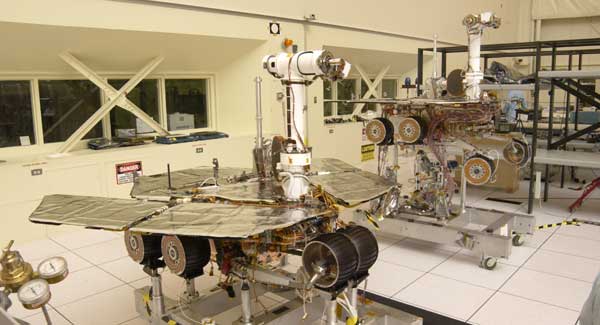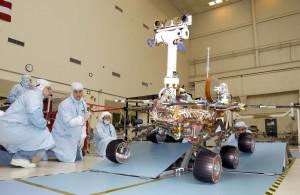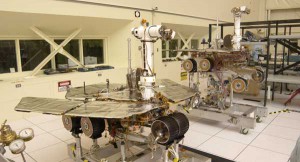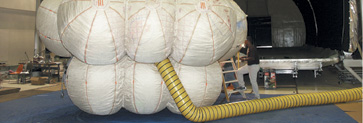
By Mary Bothwell
My division was charged with building a suite of cameras for the Mars Exploration Rover (MER) project. We were building the science cameras on the mass assembly, the microscope camera, and the hazard and navigation cameras for the rovers. Not surprisingly, a lot of folks were paying attention to our work — because there’s really no point in landing on Mars if you can’t take pictures.
In spring 2002 things were not looking good. The electronics weren’t coming in, and we had to go back to the vendors. The vendors would change the design, send the boards back, and they wouldn’t work. On our side, we had an instrument manager in charge who I believe has the potential to become a great manager, but when things got behind schedule he didn’t have the experience to know what was needed to catch up.
As division manager, I was ultimately responsible for seeing that all my project and instrument managers delivered their work. I had to make the decision whether or not to replace him.
Insight from oversight
After talking with the instrument manager’s immediate supervisor, I could see that he was doing an excellent job of keeping people motivated and working despite the challenges. For the morale of the team, I decided not to replace him — but I knew that he needed a little more horsepower behind him.
I began working with the instrument manager and got the deputy section manager involved as his day-to-day mentor. The deputy section manager actually took over running the schedule and realigned it to meet the MER project’s needs.
I met with the instrument manager and the deputy section manager every day for a while. We would go around the table and discuss the schedule. We had it on an 11×17 piece of paper that the deputy section manager had put together. We went over every item. We would say, “Okay camera number three — are you really going into thermal vacuum today? Are you really ready to do the calibration on camera number four today?”

MER project staff drive a rover over staggered ramps in the laboratory to test the suspension’s range of motion.
With 650 people in my division, and a half-dozen to a dozen projects to track at any given time, I don’t usually get involved at this level on a project. I have neither the time nor inclination for this sort of heavy-handed management, but because the cameras were so important, I had to get involved.
The instrument manager probably felt bad for a month, but he knew that changes needed to be made. Let me make something clear here: We didn’t say, “You’re doing a terrible job.” We never used words like, “If you don’t get these things done, you’re fired.” What we said at our meetings was more along the lines of “We have a problem here, and we need to find a way to succeed.”
Not only did I meet with the project team and management, but every day I would walk around to where members of the team were working and ask, “How’s it going now? Did you get that answer yet?”
Because of that level of involvement, I knew what the challenges were so that I could forecast where the project might run into trouble. I am sure that I made a few lives miserable during this time. There was a little bit of, “Well, we really don’t have a problem. We’re going to be able to fix this ourselves.”
But once they figured out they couldn’t get rid of me, they became forthcoming about the problems. If I saw someone in the hall and asked, “Hey how’s it going? Are you there?” I began hearing, “Oh yeah, we’re there,” or “Oh no, we didn’t quite make it and this is what we’re doing.”
After several months, I was able to ease up, but I kept holding weekly meetings so that the team, down to the floor-level technician, knew that I remained engaged in the project. As a matter of fact, I remember that at one of these meetings, one of the technicians looked at me and asked, “Why are you pushing us so hard?”

A landscape taken by the Spriit rover’s panoramic camera stretches west towards hills named after the Apollo 1 astronauts, who perished during a launch pad test of their spacecraft at Kennedy Space Center on January 27, 1967.
I explained our position clearly to everyone at the meeting: We were the “eyes” for the entire mission; it would not and could not fly without our cameras. If we fell too far behind on our schedule, we would drag the entire project down with us. That technician didn’t complain again.
Some people might think it courageous that he questioned me that way, but one of the things that I’ve always tried to do in my division is have an open door policy. Everyone knows they can come and talk to me about anything. They call me on the phone, and they know I answer my own phone. If they send an email, they know I’ll respond. They know that if they have to see me and I’m not around, that my assistant will work to find them time on my schedule.
We are tested
One of the things that I pushed the instrument manager on was asking if the team had enough people to complete the testing. We needed to do 24-hour qualification soaks on the cameras in a vacuum prior to science calibration. When we worked the schedule out and worked out the staffing that was required and looked at the two other projects that we had in thermal vacuum at the time, we realized that there weren’t enough people. Fortunately, we figured this out two weeks ahead, and not when there was no one to take a 4 p.m. second shift.

A rover sits at rest in the lab. The MER mission’s “eyes,” panoramic (Pancam) and navigational (Navcam) cameras, sit atop the rover’s white mast.
We could have had the project team work 12-hour shifts in order to cover the testing schedule. But I noticed that we were starting to see them dragging, and they were already under so much pressure that I was concerned about them making mistakes. I decided to take some of the shifts myself and I enlisted other managers who were capable of doing this work — so that we could give the team some relief during a time when the testing was not critical. Everyone I recruited had some past integration test experience.
My time slot was 4 p.m. to midnight on Saturday and Sunday nights a couple of weekends in a row. You have to rearrange your life to do this, but it’s absolutely the right thing to do. We didn’t need to use the subject matter experts.
It wasn’t technically challenging work, and much of it was boring. You just sit there and take a measurement once an hour. We simply needed someone who could look at the scope and say, “It’s in-spec,” or “It’s out-of-spec.” If it was out-of-spec, you made a phone call and found out what to do next. I made a couple of phone calls on my shift when the temperature got a bit too high or too low, and was talked through the process so that I could adjust the temperature.
By offering relief to the troops at this point, they were fresh for the part of the testing program where their expertise was absolutely critical. That’s something a project manager learns to do over time, and something that a project sponsor should always watch for. To ask, “Are we pushing our people too hard? Can we come up with an alternative solution that will keep us on schedule? Can we add outside people during non-critical times? Can we tell people who need a break to go home for the weekend?”
And in the end…
As we closed in on delivery, there came a point that my interactions with the instrument manager were more along the lines of, “Hi. How’s it going? We’re doing such-and-such test? Oh, okay. How do the scientists like it? Great.” Everything was just going fine. While we never caught up to the original schedule, the cameras were completed in time to be integrated onto the spacecraft and rovers. The instrument team delivered superb cameras that satisfied their customers, the scientists.

Spirit’s panoramic camera captures an image of the rover’s landing site, the Columbia Memorial Station at Gusev Crater.
After delivery, we had a party. We rented a bowling alley, all of the lanes. Some of us threw strikes and some of us gutter balls, but we bowled together all afternoon and had a wonderful time. We had much to celebrate, after all; the instrument manager and his team could feel proud of what they’d accomplished.
We had the opportunity to celebrate those accomplishments, once again, after the successful Mars landings — with all the world looking at pictures our cameras had delivered.
Lessons
- Project sponsors must be prepared to move from monitoring to intervening when a project runs into trouble. Timing is everything; a project sponsor must recognize both when intervention is necessary and when it is no longer needed.
- Effective managers demonstrate leadership by supporting their teams — including managing-by-walking-around and serving as a “soldier” when needed.
Question
How do you draw the line between destructive micro-management and constructive, intensive help?
Search by lesson to find more on:
- Leadership
- Mentoring







